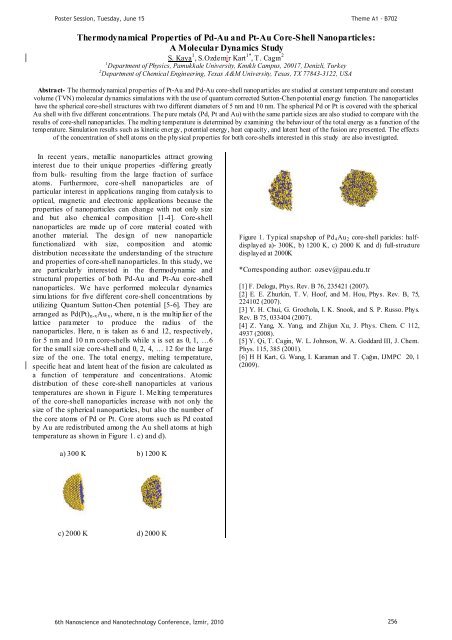Photonic crystals in biology
Photonic crystals in biology
Photonic crystals in biology
You also want an ePaper? Increase the reach of your titles
YUMPU automatically turns print PDFs into web optimized ePapers that Google loves.
Poster Session, Tuesday, June 15<br />
Theme A1 - B702<br />
Thermodynamical Properties of Pd-Au and Pt-Au Core-Shell Nanoparticles:<br />
A Molecular Dynamics Study<br />
S. Kaya 1 , S.Ozdemir Kart 1* , T. Cag 2<br />
1 <br />
2<br />
Department of Chemical Eng<strong>in</strong>eer<strong>in</strong>g, Texas A&M University, Texas, TX 77843-3122, USA<br />
Abstract- The thermodynamical properties of Pt-Au and Pd-Au core-shell nanoparticles are studied at constant temperature and constant<br />
volume (TVN) molecular dynamics simulations with the use of quantum corrected Sutton-Chen potential energy function. The nanoparticles<br />
have the spherical core-shell structures with two different diameters of 5 nm and 10 nm. The spherical Pd or Pt is covered with the spherical<br />
Au shell with five different concentrations. The pure metals (Pd, Pt and Au) with the same particle sizes are also studied to compare with the<br />
results of core-shell nanoparticles. The melt<strong>in</strong>g temperature is determ<strong>in</strong>ed by exam<strong>in</strong><strong>in</strong>g the behaviour of the total energy as a function of the<br />
temperature. Simulation results such as k<strong>in</strong>etic energy, potential energy, heat capacity, and latent heat of the fusion are presented. The effects<br />
of the concentration of shell atoms on the physical properties for both core-shells <strong>in</strong>terested <strong>in</strong> this study are also <strong>in</strong>vestigated.<br />
In recent years, metallic nanoparticles attract grow<strong>in</strong>g<br />
<strong>in</strong>terest due to their unique properties -differ<strong>in</strong>g greatly<br />
fro m bulk- result<strong>in</strong>g fro m the large fraction of surface<br />
atoms. Furthermore, core-shell nanoparticles are of<br />
particular <strong>in</strong>terest <strong>in</strong> applications rang<strong>in</strong>g from catalysis to<br />
optical, magnetic and electronic applications because the<br />
properties of nanoparticles can change with not only size<br />
and but also chemical composition [1-4]. Core-shell<br />
nanoparticles are made up of core material coated with<br />
another material. The design of new nanoparticle<br />
functionalized with size, composition and atomic<br />
distribution necessitate the understand<strong>in</strong>g of the structure<br />
and properties of core-shell nanoparticles. In this study, we<br />
are particularly <strong>in</strong>terested <strong>in</strong> the thermodynamic and<br />
structural properties of both Pd-Au and Pt-Au core-shell<br />
nanoparticles. We have performed molecular dynamics<br />
simulations for five different core-shell concentrations by<br />
utiliz<strong>in</strong>g Quantum Sutton-Chen potential [5-6]. They are<br />
arranged as Pd(Pt) n-xAu x , where, n is the mu ltip lier of the<br />
lattice parameter to produce the radius of the<br />
nanoparticles. Here, n is taken as 6 and 12, respectively,<br />
for 5 nm and 10 nm core-shells while x is set as 0, 1, …6<br />
for the small size core-shell and 0, 2, 4, … 12 for the large<br />
size of the one. The total energy, melt<strong>in</strong>g temperature,<br />
specific heat and latent heat of the fusion are calculated as<br />
a function of temperature and concentrations. Atomic<br />
distribution of these core-shell nanoparticles at various<br />
temperatures are shown <strong>in</strong> Figure 1. Melt<strong>in</strong>g temperatures<br />
of the core-shell nanoparticles <strong>in</strong>crease with not only the<br />
size of the spherical nanoparticles, but also the number of<br />
the core atoms of Pd or Pt. Core atoms such as Pd coated<br />
by Au are redistributed among the Au shell atoms at high<br />
temperature as shown <strong>in</strong> Figure 1. c) and d).<br />
Figure 1. Typical snapshop of Pd 4 Au 2 core-shell paricles: halfdisplayed<br />
a)- 300K, b) 1200 K, c) 2000 K and d) full-structure<br />
displayed at 2000K<br />
*Correspond<strong>in</strong>g author: ozsev@pau.edu.tr<br />
[1] F. Delogu, Phys. Rev. B 76, 235421 (2007).<br />
[2] E. E. Zhurk<strong>in</strong>, T. V. Hoof, and M. Hou, Phys. Rev. B, 75,<br />
224102 (2007).<br />
[3] Y. H. Chui, G. Grochola, I. K. Snook, and S. P. Russo. Phys.<br />
Rev. B 75, 033404 (2007).<br />
[4] Z. Yang, X. Yang, and Zhijun Xu, J. Phys. Chem. C 112,<br />
4937 (2008).<br />
[5] Y. Qi, T. Cag<strong>in</strong>, W. L. Johnson, W. A. Goddard III, J. Chem.<br />
Phys. 115, 385 (2001).<br />
[6] H H Kart, G. Wang, I. Karaman an<br />
(2009).<br />
a) 300 K<br />
b) 1200 K<br />
c) 2000 K d) 2000 K<br />
6th Nanoscience and Nanotechnology Conference, zmir, 2010 256













